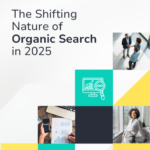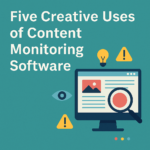04 Mar

SEO Monitoring Trends in 2024
2023 was a landmark year in SEO, and not for entirely positive reasons. After the emergence of OpenAI and ChatGPT and the realization that AI-powered search was the future focus of major search players like Google and Microsoft, SEO monitoring professionals were rightly thrown into an uncertain landscape. Would traditional search, and all of its standard practices and strategies, disappear within months? What about the ideas of “content is king” and the importance of link-building? Would there even be a future for SEO?
The volatility did not stop there. Google released a series of major updates throughout 2023 that seemed geared toward adjusting to AI tools and their ability to be used for gaming search results, leading to one of the most volatile years for SERPs ever. The notorious fall Helpful Content update caused significant upheaval and major damage to many sites, and the scramble continues to adjust SEO monitoring strategy to an ever-shifting landscape for both Google and Bing.
So what does this mean for SEO professionals and novices alike? What should industry pros be focusing on in 2024, and into an AI-influenced future? Here are three of our top SEO monitoring trends to watch in the coming year.
#1: Expect Frequent Algorithm Updates to Continue
While every SEO pro knows the dread of seeing the news of a new Google update hit their feeds and inboxes, 2023’s core updates were even worse. With seemingly four transformative core updates and nine tracked updates total (all with significantly different impact) search professionals are still struggling to backwards engineer Google’s shifting priorities that were rolled out in 2023. However, while the optimists may hope that this frequency of updates was a natural response after the rollout of ChatGPT (and the ability for a wider audience to quickly create mountains of content to game search results), the reality is this might be the norm going forward.
Since Google algorithm updates are generally rolled out to evolve to meet new techniques of gaming search, the speed of AI means that Google will need to continue evolving search to match it. This is on top of Google’s rollout of Gemini (which might be delayed more than expected thanks to the backlash around its recent announcement), which also means that Google already has an eye on a transformative new approach to search to rival ChatGPT and Microsoft. While it’s never possible to predict the total number of updates in a given year, SEO monitoring profs should probably expect 2024 to at least approach if not exceed the upheaval of 2023.
#2: Rethinking "Content is King"
Even novices to SEO know the basic content strategy that has been touted by the industy for the past few years. Ideas like keyword density, header usage and nested sub-headers, a focus on readability – anyone could teach themselves to create optimal content for their blogs or landing pages. However, by all indications, the September Helpful Content update had a massive impact that brings this tried-and-true strategy into question. Sites that had rolled out frequent blogs that were shallow on true authoritative content and depth in favor of keyword stuffing took major hits that many still haven’t recovered from. This has left site owners and content creators scrambling for months to regain site authority, many of whom have probably lost their previously dominant positions for good.
So what should SEO monitoring profs consider when thinking about content strategy in 2024?
- The importance of thoughtful site architecture, including topic clusters and URL hierarchies. Sites with logical “file cabinet” structures for their content seemed to survive algorithm changes more successfully than volume blogs.
- Focus on the extra E in E-E-A-T. Experience was added as a core ranking factor for a reason. As Google targets search to AI, which will reveal just a few high-quality links as opposed to the endless scroll of links of the past, ensuring content includes actual human authority (quotes, statistics, infographics, relevant links, anchor text that indicates relevance) will take precedence over pure volume of content. Sorry, no creating hundreds of blogs with GPT SEO profs.
- Cross-promotional content partnerships, which allow for both higher quality content and natural backlinking relationships, should be the gold standard. It won’t be enough to just backlink to the first site you see in Google search. Instead, co-developing content with partners to ensure the topical relationship is strong on both sites will be key.
#3: Prepare for the Post-SEO Future
While AI’s frequent flaws have been exposed in detail by both SEO monitoring professionals and the general media alike, the writing is on the wall for traditional SEO. Pandora’s Box has been opened, and a future where voice-driven and AI-curated search is the norm and not the newest trend is only a matter of time. SEO profs who are clinging to their time-tested strategies stubbornly may be able to succeed in the near-term, but it’s key to start planning for a post-SEO future. The term GEO (generative engine optimization) is being thrown around to describe this reality, but given no one knows what form or when this will take effect, much of the strategy will need to be developed incrementally as more of the powers and preferences of AI search engines are slowly revealed.
In the meantime, smart SEO monitoring profs can focus on building the groundwork for a major shift in technique and strategy that will need to happen:
- Staying plugged in on announcements from the major search players, most importantly OpenAI/Microsoft and Google. Don’t discount the importance of even minute details in press releases and product updates, given they are often clues into where algorithms may evolve.
- For linkbuilding efforts, start moving away from domain authority is the deciding factor for choosing link partners and instead look for common audiences and topical ground.
- Given voice search is most often started with a question, auditing existing content and LPs to ensure all content answers a question is a way to keep old content usable.
- Begin preparing clients or stakeholders who may not be aware of the volatile SEO future for the significant changes to come. Since SEO is not the easiest thing to explain to clients in terms of value and results, building the groundwork now for major volatility can help clients keep reasonable expectations, especially if they have been watching positive trendlines suddenly reverse over the past year.
- If a site’s content strategy has been exclusively text based, now is the time to start integrating video and images to better match AI-generated search results. Google and Microsoft have both publicly admitted that visual search will be prioritized more in the future, so starting this groundwork now before an update that implements this shift is key to avoid a drastic drop in SERPs.
Adam Hausman has worked with ChangeTower since its founding in 2018 and is passionate about the potential of website monitoring software in industries including SEO, compliance monitoring, competitive intelligence, and more. Also founder of Greenlight Growth Marketing, he holds degrees from Indiana University (BA English/Psychology 2008) and the University of Illinois-Chicago (M.Ed. Secondary Education 2012). He lives in Maine with his wife, 2 kids, and 2 annoying cats.





Adam Hausman